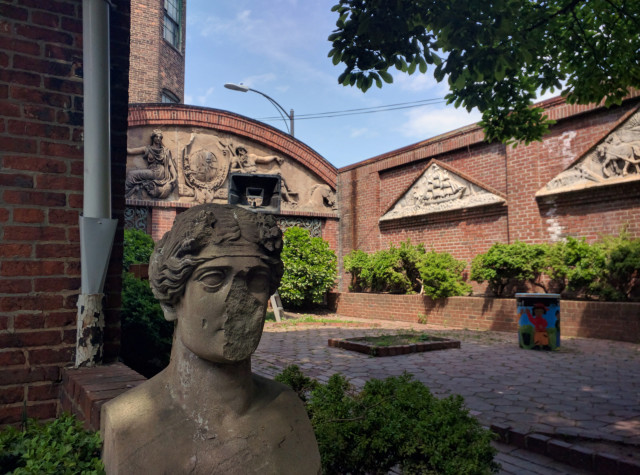
The Peale Museum courtyard houses sculptural details salvaged from buildings slated to be demolished. I’m told the frieze in the background was the first piece of architectural sculpture in the colonies. The bullhorn is an intervention by DeVille titled “Airing of Grievances”. It’s pointed at City Hall.
Abigail DeVille: Only When It’s Dark Enough Can You See The Stars
The Contemporary at the Peale Museum
225 N. Holiday St., Baltimore, MD
When the Peale Museum opened in 1814, it was the first structure in the Western Hemisphere to be built specifically as a museum. I was born, and live, just over a mile from the place and didn’t know about this fact until a few weeks ago. The museum was the brainchild of Rembrandt Peale, a member of “the first family of American artists.” He filled it with natural history specimens, the family’s paintings, and other wunderkammer curios. Before the museum opened, the family disguised it as a house, sleeping in its parlors, to hide what might be considered a civic asset from British troops in the War of 1812. It was here that gas lighting was first introduced to the American public, and Rembrandt Peale went on to establish the country’s first gas utility.
The museum’s first life was short-lived, however. In 1830, it was renovated and served as Baltimore City Hall for 44 years. It then became the first secondary school for African Americans. Somewhere along this timeline, the structure was filled with trash, cleared of trash, became the Bureau of Water Supply, survived the great fire of 1904, housed an organ maker, a sign painting workshop, a mattress factory, and was extensively remodelled after being condemned. In 1931, it became the Municipal Museum, and later the Peale Museum again. It was closed in 1996, its treasures bestowed to the Maryland Historical Society. Former Mayor Kurt Schmoke wanted it demolished, and preservationists responded by re-branding it “The Kurt L. Schmoke Conference Center at The Peale Museum”. It’s been vacant due to ADA noncompliance for roughly a decade.
It’s a lot to take in.
These facts (or perhaps, occasionally, exaggerations) are but a fraction of the information viewers are left to sift through in Abigail DeVille’s Only When It’s Dark Enough Can You See The Stars, a research-intensive series of site-specific installations that spans the entire Peale Museum. This is the latest project from The Contemporary (née Museum) is an itinerant institution that’s been without a building of its own since 2011. The irony of the institution occupying the nation’s first museum building, now vacant and without a program of its own, is just one of the connections that struggled its way to clarity when visiting the show. Content overload—written, visual, auditory, found, and fabricated—is the defining approach in DeVille’s work here. It’s sometimes unclear what’s important, arbitrary, existing context, or staged intervention. DeVille plays the part of an archaeological excavator, churning up landfill and artifact alike. We’re left to curate and make sense of the spoils ourselves.
At times, information is deliberately obfuscated and later hinted at. The Museum’s surprisingly humble foyer is crammed with placards like one might see during a protest or election season. Whatever messages they might’ve once held have been redacted with sloppy black paint, leaving them as blank slates. When I first saw the show, I thought these were an odd choice for the entrance, because it’s by far the least inviting or approachable installation in the show. It felt as if DeVille had started at the top, where the most polished pieces are, and worked her way down to an afterthought.
In retrospect, the piece reads like a prelude or coda to the wheat-pasted blocks of text installed on the stairwell leading to the second floor—a timeline of protests and civil disturbances in front of City Hall, from riots leading up to the War of 1812 and Civil War to labor disputes and post-war marches that foreshadowed the Civil Rights movement. With these events in mind, the redacted placards read as a haphazard monument to all of history’s mostly-forgotten pedestrian politics.
But the rest of the first floor feels like a celebratory protest against the very idea of editing. Installations comprising objects found on site, historic ephemera, reproductions, and junk the city never threw out are staged in elaborate, chaotic tableaus. The rooms feel a bit like theatrical sets, or perhaps a haunted house—all of the Peale Museum’s ghosts are simultaneously resurrected from its many lives. The identities of museum, factory, school, civic building, and forgotten storage facility are summoned and bleed into one another. Horror vacui takes on a whole new meaning here.

Abigail DeVille, “Colored Grammar School No. 1 1874-1888” installation view.
In the installation “Colored Grammar School No. 1 1874-1888”, DeVille pays homage to the fourteen years the Peale Museum housed the city’s first secondary school for African Americans. Precarious stacks of slates form an obstacle course on the floor, walls are smeared with charcoal, and perforated black plastic filters the sunlight into scattered constellations. Every blank surface feels addressed, but few feel resolved, contributing to a palpable sense of anxiety in the space. It’s an impression that’s not quite assuaged even when DeVille gives us salient details to focus on. After rounding a barricade to look at the seated figure reading a reproduction of a period textbook, it’s revealed that he’s wearing a contemporary hoodie and his face has been replaced with shards of shattered mirror—two powerful signifiers of an identity obscured, both carrying an association with violence. Scattered old window frames hold hopelessly faded and under-lit historical photos of black students. Here, too, the identities of the figures feel forgotten. There’s an evocation of makeshift stained glass windows, as if to remind us these people were never immortalized as icons.
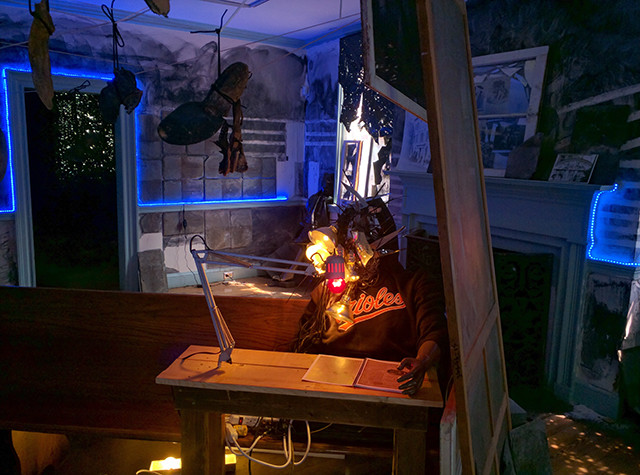
Abigail DeVille, “Colored Grammar School No. 1 1874-1888” installation view.
The next room, “Charles Wilson Peale”, feels a bit like a visual palate cleanser punctuating two overwhelming installations. It’s a chance to recalibrate one’s bearings with the culture of display, from a curio vitrine stocked with surprisingly tender arrangements to reproductions of the Peale family’s oil paintings. As if to announce that this vision of the 19th century museum ideal is long gone, a controlled landslide of debris spills from the mouth of a marble fireplace. The room is bathed in #aesthetic Pantone 2016 blue-and-pink lighting, never allowing us to forget that we’re looking at a film-set simulacra of a museum within a museum. Ironically, that sense of artifice and the structure of the wunderkammer might’ve liberated DeVille to produce some of the most successful moments in the show—her mini-installations in the display cases function very differently than her ambitious room-sized works. The scale is more approachable, and somehow more endearing. Weird pieces of taxidermy, broken sculptures, and other fragments of things that once were are re-gifted a sense of preciousness, and speak equally to wonder and memento mori.
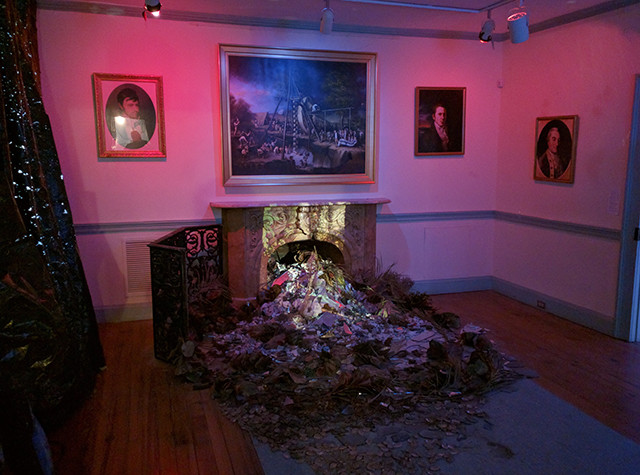
Abigail DeVille, Charles
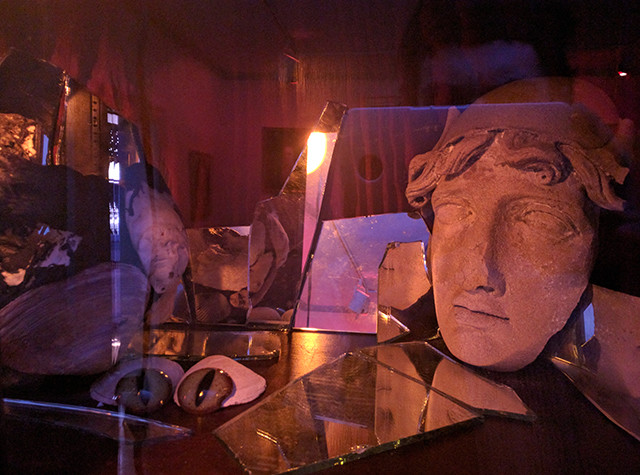
Abigail DeVille, “Charles Wilson Peale” detail of installation in vitrine.
The entire rear of the first floor again takes us on a giant leap in terms of scale. “Charm City Roundhouse” is a gallery-wide composition, similarly inverting senses of the grandiose or precious. There’s a giant American flag painted on a tattered tarp, cascading into mountains of junk: chandeliers found in the building’s basement, butchers paper, and mannequin legs to name a few. Opposite the flag, a series of blown-up illustrations and text about a mastodon that Charles Willson Peale discovered and displayed (the family’s inspiration for starting a museum) lay on the floor. That marked a major turning point in humanity’s understanding of biology—the discovery of the mastodon provided evidence than an entire species could go extinct, paving the way for Darwin’s theory of evolution. Interestingly, neither the image of the mastodon nor the flag (an allusion to the original Betsy Ross “Star Spangled Banner”, sewn a few blocks away from the museum during its construction) is presented as fully intact or displayed with any more hierarchical differentiation than a derelict bicycle. They’re all fragments of an endlessly-building heap of remembered or forgotten history and trivia.
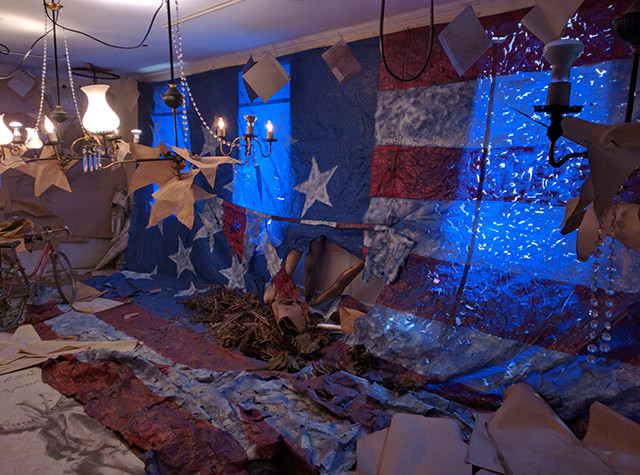
Abigail DeVille, “Charm City Roundhouse”
That impression is reinforced upstairs, where “impermanent” fragments of derelict vernacular architecture—white picket fences, trellises, and storm doors—are arranged into a funhouse-like structure called “Invisibility Blues”. It’s a clever counterpoint to the Museum’s collection of architecturally significant details salvaged from historic buildings throughout the 20th century. A frieze embedded in the courtyard walls, I was told, is the first piece of “architectural artwork” in the United States. It was rescued from an early government building when it was demolished and moved to the Peale for safe keeping.

Abigail DeVille, “Invisibility Blues”.
DeVille’s architectural interventions are some of the greatest triumphs in Only When It’s Dark Enough Can You See The Stars, and “The People’s Theater” is a testament to what can be achieved with an economic use of materials, lighting, and sound. She’s draped black plastic over the ceiling and skylight, creating a night sky that’s awe-inspiring and recalls the cinematic quality of the Alhambra or great religious structures. Quiet music by Justin Hicks, Kenita R. Miller-Hicks, and Jade Hicks plays in addition to an open mic. The public can come in and use the space for gatherings or performances throughout the duration of the show. I was told other artworks might be added here, but I wish it stayed relatively pristine just like this—in an exhibition all about sifting through the burden/treasure trove of history, this open space feels optimistically-utopian.
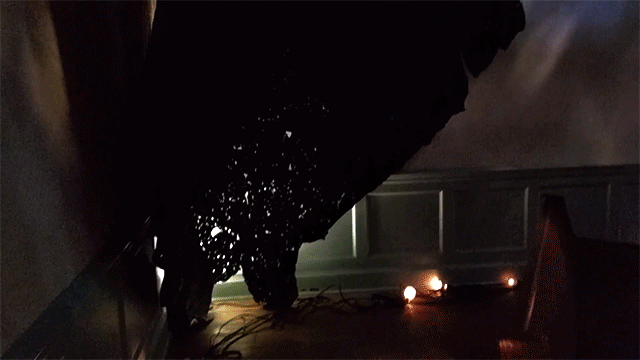
Abigail DeVille, “The People’s Theater,” installation view.
DeVille pairs that audio track with an installation in another room, “Black Whole,” which comprises hundreds of trash cans stacked sideways, contents spilling out, and a flashing strobe light. It’s claustrophobic, and again feels a bit like a haunted house. Here though, I get the impression that the terror isn’t the weight of history, but its unknowability. Even if an archivist could shift through a fraction of the detritus in the vessels, they’d be unable to decipher any meaning through the rapidly-flashing light in an otherwise dark room. There’s something primally terrifying about knowing you’re in a confined space with so much stuff and not knowing what any of it is.
By the time I reached the final gallery, which contained a dry cleaning rack rotating a carousel of assorted old junk, I found myself wondering “wow, was the Peale Museum once a dry cleaning place once too?” I then realized, it doesn’t really matter. The endless, noisy procession of objects doesn’t seem to imply any narrative, and that might be the point. Rusted pots and pans, prosthetic limbs, an old hair dryer—all point to a vague, obsessive nostalgia for obsolete crap, and some postapocalyptic conservation lab. There’s nothing that can be done with this information, but its conspicuous display is hypnotic and unavoidable. The mechanism literally generates so much racket and vibration it can be felt throughout the building, as if the inertia of objects’ endless orbit were slowly grinding the Museum’s foundation to dust.

Opposite the contraption, facing the backs of viewers, a grid of television monitors futily competes for attention. I can’t even remember if their audio was even playing—it would’ve been utterly drowned-out by the display machine. The videos were sourced from various alternative media sources, documenting events such as Civil Rights marches and last year’s protests over the murder of Freddie Gray. There’s an obvious urgency to their content, seemingly positioned in contrast to the relatively trivial spectacle of yesteryear’s minutiae. Tellingly, many of the television screens had gone dark or displayed static. Collectively, the work is titled “‘But somewhere I read of the freedom of assembly. Somewhere I read of the freedom of speech. Somewhere I read of the freedom of press. Somewhere I read that the greatness of America is the right to protest for right.’ -MLK, Mountaintop speech, April 3, 1968.”

I might be projecting that conflict between two modes of representing “history”, but comparisons with Fred Wilson’s seminal Mining the Museum (also presented by The Contemporary, nearly a quarter century ago) feel unavoidable. Wilson meticulously re-curated the Maryland Historical Society’s collections to reflect the discrepancies between the way African American and European American histories are archived and presented. In Abigail Deville’s ambitious exhibition, one leaves with the impression that all history is too messily intertwined and tortuously rooted to be excavated without making a mess. The past seldom sits politely in a vitrine—it lurks in dark closets, spills across floors, and sometime, into the street.
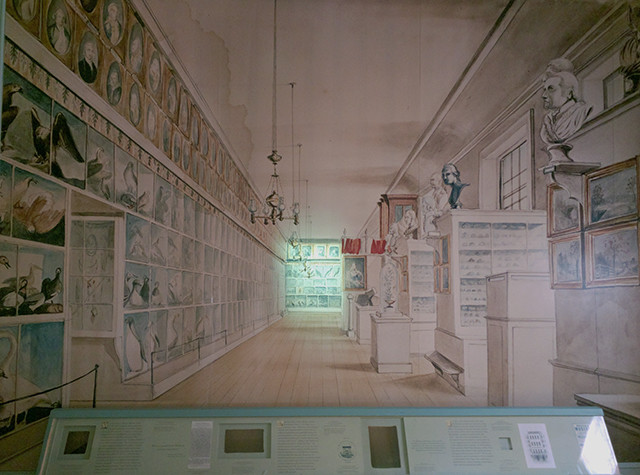
An old, faded and waterlogged mural depicting the museum as it might’ve looked when it first opened.


Comments on this entry are closed.
{ 1 trackback }